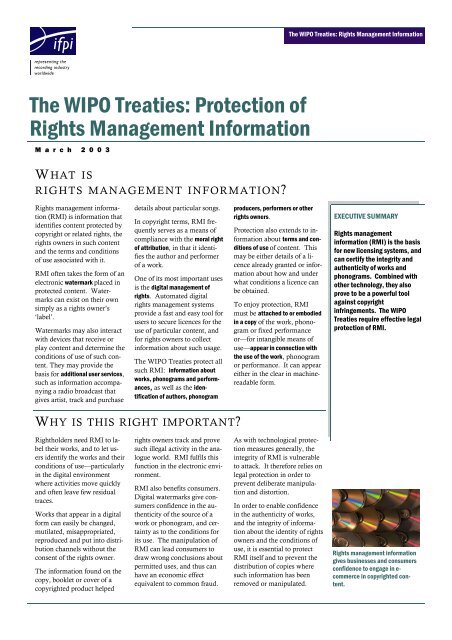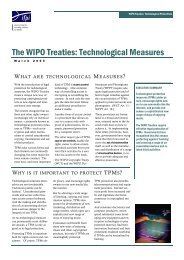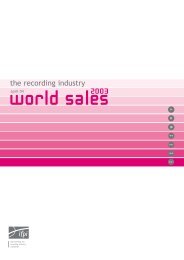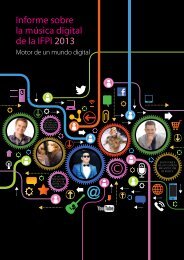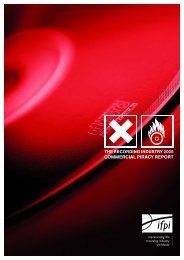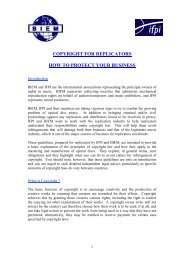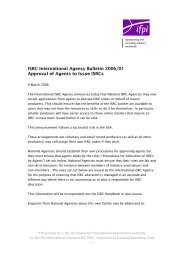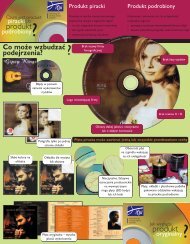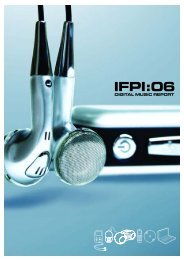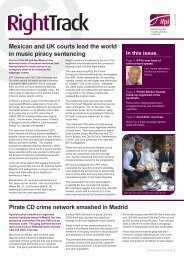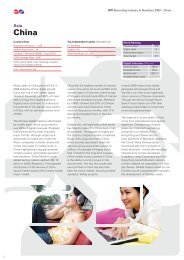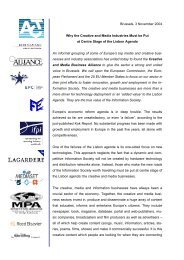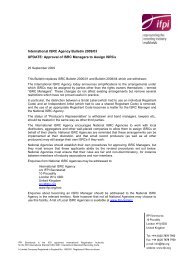WIPO Treaties: Rights Management Information - IFPI
WIPO Treaties: Rights Management Information - IFPI
WIPO Treaties: Rights Management Information - IFPI
Create successful ePaper yourself
Turn your PDF publications into a flip-book with our unique Google optimized e-Paper software.
The <strong>WIPO</strong> <strong>Treaties</strong>: <strong>Rights</strong> <strong>Management</strong> <strong>Information</strong><br />
The <strong>WIPO</strong> <strong>Treaties</strong>: Protection of<br />
<strong>Rights</strong> <strong>Management</strong> <strong>Information</strong><br />
M a r c h 2 0 0 3<br />
W HAT IS<br />
RIGHTS MANAGEMENT INFORMATION?<br />
<strong>Rights</strong> management information<br />
(RMI) is information that<br />
identifies content protected by<br />
copyright or related rights, the<br />
rights owners in such content<br />
and the terms and conditions<br />
of use associated with it.<br />
RMI often takes the form of an<br />
electronic watermark placed in<br />
protected content. Watermarks<br />
can exist on their own<br />
simply as a rights owner’s<br />
‘label’.<br />
Watermarks may also interact<br />
with devices that receive or<br />
play content and determine the<br />
conditions of use of such content.<br />
They may provide the<br />
basis for additional user services,<br />
such as information accompanying<br />
a radio broadcast that<br />
gives artist, track and purchase<br />
details about particular songs.<br />
In copyright terms, RMI frequently<br />
serves as a means of<br />
compliance with the moral right<br />
of attribution, in that it identifies<br />
the author and performer<br />
of a work.<br />
One of its most important uses<br />
is the digital management of<br />
rights. Automated digital<br />
rights management systems<br />
provide a fast and easy tool for<br />
users to secure licences for the<br />
use of particular content, and<br />
for rights owners to collect<br />
information about such usage.<br />
The <strong>WIPO</strong> <strong>Treaties</strong> protect all<br />
such RMI: information about<br />
works, phonograms and performances,<br />
as well as the identification<br />
of authors, phonogram<br />
producers, performers or other<br />
rights owners.<br />
Protection also extends to information<br />
about terms and conditions<br />
of use of content. This<br />
may be either details of a licence<br />
already granted or information<br />
about how and under<br />
what conditions a licence can<br />
be obtained.<br />
To enjoy protection, RMI<br />
must be attached to or embodied<br />
in a copy of the work, phonogram<br />
or fixed performance<br />
or—for intangible means of<br />
use—appear in connection with<br />
the use of the work, phonogram<br />
or performance. It can appear<br />
either in the clear in machinereadable<br />
form.<br />
EXECUTIVE SUMMARY<br />
<strong>Rights</strong> management<br />
information (RMI) is the basis<br />
for new licensing systems, and<br />
can certify the integrity and<br />
authenticity of works and<br />
phonograms. Combined with<br />
other technology, they also<br />
prove to be a powerful tool<br />
against copyright<br />
infringements. The <strong>WIPO</strong><br />
<strong>Treaties</strong> require effective legal<br />
protection of RMI.<br />
WHY IS THIS RIGHT IMPORTANT?<br />
Rightholders need RMI to label<br />
their works, and to let users<br />
identify the works and their<br />
conditions of use—particularly<br />
in the digital environment<br />
where activities move quickly<br />
and often leave few residual<br />
traces.<br />
Works that appear in a digital<br />
form can easily be changed,<br />
mutilated, misappropriated,<br />
reproduced and put into distribution<br />
channels without the<br />
consent of the rights owner.<br />
The information found on the<br />
copy, booklet or cover of a<br />
copyrighted product helped<br />
rights owners track and prove<br />
such illegal activity in the analogue<br />
world. RMI fulfils this<br />
function in the electronic environment.<br />
RMI also benefits consumers.<br />
Digital watermarks give consumers<br />
confidence in the authenticity<br />
of the source of a<br />
work or phonogram, and certainty<br />
as to the conditions for<br />
its use. The manipulation of<br />
RMI can lead consumers to<br />
draw wrong conclusions about<br />
permitted uses, and thus can<br />
have an economic effect<br />
equivalent to common fraud.<br />
As with technological protection<br />
measures generally, the<br />
integrity of RMI is vulnerable<br />
to attack. It therefore relies on<br />
legal protection in order to<br />
prevent deliberate manipulation<br />
and distortion.<br />
In order to enable confidence<br />
in the authenticity of works,<br />
and the integrity of information<br />
about the identity of rights<br />
owners and the conditions of<br />
use, it is essential to protect<br />
RMI itself and to prevent the<br />
distribution of copies where<br />
such information has been<br />
removed or manipulated.<br />
<strong>Rights</strong> management information<br />
gives businesses and consumers<br />
confidence to engage in e-<br />
commerce in copyrighted content.
The <strong>WIPO</strong> <strong>Treaties</strong>: <strong>Rights</strong> <strong>Management</strong> <strong>Information</strong><br />
Page 2<br />
H OW SHOULD THIS BE IMPLEMENTED?<br />
<strong>WIPO</strong> TREATY TEXT<br />
WPPT Art. 19.<br />
(1) Contracting Parties shall<br />
provide adequate and effective<br />
legal remedies against any person<br />
knowingly performing any of the<br />
following acts knowing, or with<br />
respect to civil remedies having<br />
reasonable grounds to know, that<br />
it will induce, enable, facilitate or<br />
conceal an infringement of any<br />
right covered by this Treaty:<br />
(i) to remove or alter any<br />
electronic rights management<br />
information without authority;<br />
(ii) to distribute, import for<br />
distribution, broadcast,<br />
communicate or make available<br />
to the public, without authority,<br />
performances, copies of fixed<br />
performances or phonograms<br />
knowing that electronic rights<br />
management information has<br />
been removed or altered without<br />
authority.<br />
(2) As used in this Article, ‘rights<br />
management information’ means<br />
information which identifies the<br />
performer, the performance of the<br />
performer, the producer of the<br />
phonogram, the phonogram, the<br />
owner of any right in the<br />
performance or phonogram, or<br />
information about the terms and<br />
conditions of use of the<br />
performance or phonogram, and<br />
any numbers or codes that<br />
represent such information, when<br />
any of these items of information<br />
is attached to a copy of a fixed<br />
performance or a phonogram or<br />
appears in connection with the<br />
communication or making<br />
available of a fixed performance<br />
or a phonogram to the public.<br />
Most countries are finding that<br />
their copyright laws require<br />
some modernising to deal adequately<br />
with the legal protection<br />
of RMI. There are several<br />
elements that governments<br />
and right holders have found<br />
crucial to ensure the effective<br />
legal protection of RMI:<br />
•Definition of RMI. The starting<br />
point is the definition of RMI.<br />
The treaties themselves provide<br />
a clear and useful definition,<br />
which may be useful to<br />
include in implementing legislation.<br />
The definition must include<br />
the required categories of protected<br />
information (information<br />
on works, phonograms<br />
or performances; on the identity<br />
of the author, the phonogram<br />
producer or the performer;<br />
or on the terms and<br />
conditions of use).<br />
It should also indicate that the<br />
information must be attached<br />
to a work, a fixation of a performance<br />
or a phonogram, or<br />
must appear in connection<br />
with any intangible type of use<br />
including the communication<br />
to the public, broadcasting, or<br />
‘making available’.<br />
•Protection against manipulation<br />
of RMI. One of the treaties’<br />
main aims of protection is the<br />
prohibition of manipulation of<br />
RMI. The treaties explicitly<br />
mention the unauthorised removal<br />
and alteration of RMI.<br />
Another type of manipulation<br />
of RMI having equivalent effect<br />
is the unauthorised addition<br />
of information. This activity<br />
can mislead users and businesses<br />
as to permitted uses and<br />
discourage the use of RMI,<br />
just as much as the removal or<br />
alteration of RMI does.<br />
•Protection against dissemination<br />
of copies in which RMI has<br />
been manipulated . The second<br />
main element of protection is<br />
the prohibition of activities<br />
relating to copies as to which<br />
RMI has been removed or altered<br />
without authorisation.<br />
To enable rights owners to<br />
take such copies out of circulation<br />
and prevent further harm,<br />
it is important to provide a<br />
complete list of prohibited activities<br />
including distribution,<br />
export, import for distribution,<br />
broadcasting, communication to<br />
the public, and the making available<br />
to the public of such copies.<br />
•Knowledge requirement regarding<br />
the impact of the activity on<br />
copyright infringement. Activities<br />
relating to RMI need not<br />
lead to legal proceedings if<br />
they have been performed accidentally<br />
and innocently.<br />
The knowledge test established<br />
by the treaties varies depending<br />
on the type of activity. As<br />
regards the removal or alteration<br />
of RMI without authorisation,<br />
the test is whether the<br />
person knew, or in the case of<br />
civil proceedings had reasonable<br />
grounds to know, that<br />
such manipulation would induce,<br />
enable, facilitate, or conceal<br />
infringement of copyright<br />
or neighbouring rights.<br />
As regards the dissemination<br />
without authorisation of content<br />
where RMI has been manipulated<br />
or removed, the test<br />
is whether the person knew<br />
that RMI has been manipulated<br />
or removed, as well as<br />
whether the person knew, or<br />
in the case of civil proceedings<br />
had reasonable grounds to<br />
know, that the dissemination<br />
of content without RMI (or<br />
with manipulated RMI) would<br />
induce, enable, facilitate, or<br />
conceal an infringement.<br />
•Prohibition of ‘watermark washing’<br />
devices. In parallel to the<br />
protection of technological<br />
measures, meaningful protection<br />
against RMI manipulation<br />
and removal should extend<br />
to devices designed or<br />
adapted to manipulate or remove<br />
RMI.<br />
There is a substantial danger<br />
that devices that systematically<br />
'wash out' watermarks while<br />
leaving the content unchanged<br />
will undermine the confidence<br />
of rights owners and legitimate<br />
users, which is essential to the<br />
use of rights management information<br />
in the first place.<br />
The protection required by the<br />
treaties can be achieved best<br />
by also prohibiting the manufacture,<br />
importation, distribution,<br />
offer to the public, provision<br />
or otherwise trafficking in<br />
devices designed or adapted to<br />
manipulate or remove RMI,<br />
and means with equivalent<br />
effect.
Page 3<br />
The <strong>WIPO</strong> <strong>Treaties</strong>: <strong>Rights</strong> <strong>Management</strong> <strong>Information</strong><br />
F REQUENTLY ASKED QUESTIONS (FAQS)<br />
Must countries adapt their laws to<br />
implement this protection?<br />
Yes, virtually all countries have<br />
to change their law in order to<br />
implement the protection of<br />
RMI. Protections already pro-<br />
vided under criminal law<br />
(computer fraud), moral rights,<br />
media law, trademark law, personality<br />
right or competition law<br />
typically provide only limited<br />
aspects of the required protection.<br />
Must this protection be implemented<br />
in copyright law?<br />
No. This is a new protection<br />
regime that could be enacted<br />
under other types of legislation.<br />
S AMPLE IMPLEMENTING LEGISLATION<br />
<strong>IFPI</strong> Model Legislation:<br />
(1) It shall be unlawful to remove, alter or add rights management information without authority<br />
knowing, or with respect to civil remedies having reasonable grounds to know, that this will induce,<br />
enable, facilitate or conceal an infringement of copyright or neighbouring rights.<br />
(2) It shall be unlawful to distribute, export, import for distribution, broadcast, communicate or<br />
make available to the public without authority copies of works, fixed performances or phonograms<br />
knowing that rights management information has been removed, altered or added without<br />
authority and knowing, or with respect to civil remedies having reasonable grounds to know, that<br />
this will induce, enable, facilitate or conceal an infringement of copyright or neighbouring rights.<br />
(3) It shall be unlawful to manufacture, import, distribute, export, sell, rent, possess for commercial<br />
purposes, offer to the public, advertise, communicate or otherwise provide without authority<br />
any device, product or component that is designed or adapted to remove, alter or add rights management<br />
information.<br />
(4) '<strong>Rights</strong> management information' means<br />
(a) information that identifies the work or other protected matter, the author, the performer, the<br />
producer of a phonogram or any other rights owner, or<br />
(b) information about the terms and conditions of use of the work, phonogram or performance,<br />
and<br />
(c) any number or code that represents such information,<br />
when any of these is attached to a copy of a work, phonogram or fixed performance, or appears<br />
in connection with the broadcast, communication or making available to the public of the work,<br />
phonogram or fixed performance.<br />
Other Sample Legislation: Belarus Copyright Act, Article 39:<br />
5. The following shall also be deemed infringements of copyright or related rights. . .<br />
- . . .<br />
- the removing or altering of any electronic rights management information without the consent of<br />
the holder of copyright or related rights;<br />
- the distribution, importing for the purposes of distribution, broadcasting or communication to the<br />
public without the authorisation of the holder of copyright or related rights of works, recorded<br />
performances, phonograms or broadcast or cabled programs with respect to which electronic<br />
rights management information has been removed or altered without the authorisation of the<br />
rightholder.<br />
6. Any copy of a work, a recorded performance, a phonogram or a broadcast or cabled program on<br />
which rights management has been removed or altered without the authorisation of the holder of<br />
copyright or related rights or which has been manufactured without the authorisation of the holder<br />
by means of a device used in an unlawful manner as referred to in the second indent of paragraph 5<br />
of this Article, shall be deemed an infringing copy in accordance with paragraphs 2 and 3 of this<br />
Article.<br />
<strong>WIPO</strong> TREATY TEXT<br />
WCT Art. 12.<br />
(1) Contracting Parties shall<br />
provide adequate and effective legal<br />
remedies against any person<br />
knowingly performing any of the<br />
following acts knowing, or with<br />
respect to civil remedies having<br />
reasonable grounds to know, that it<br />
will induce, enable, facilitate or<br />
conceal an infringement of any<br />
right covered by this Treaty or the<br />
Berne Convention:<br />
(i) to remove or alter any electronic<br />
rights management information<br />
without authority;<br />
(ii) to distribute, import for<br />
distribution, broadcast or<br />
communicate to the public, without<br />
authority, works or copies of works<br />
knowing that electronic rights<br />
management information has been<br />
removed or altered without<br />
authority.<br />
(2) As used in this Article, ‘rights<br />
management information’ means<br />
information which identifies the<br />
work, the author of the work, the<br />
owner of any right in the work, or<br />
information about the terms and<br />
conditions of use of the work, and<br />
any numbers or codes that<br />
represent such information, when<br />
any of these items of information is<br />
attached to a copy of a work or<br />
appears in connection with the<br />
communication of a work to the<br />
public.<br />
<strong>IFPI</strong> has represented the<br />
international recording<br />
industry since 1933. Its<br />
membership comprises more<br />
than 1,400 record producers<br />
and distributors in over 70<br />
countries. For more<br />
information, please contact<br />
<strong>IFPI</strong><br />
54 Regent Street<br />
London, England, W1B 5RE<br />
Phone: +44 (0)20 7878 7900<br />
Fax: +44 (0)20 7878 7950<br />
E-mail: info@ifpi.org<br />
Web site: www.ifpi.org


